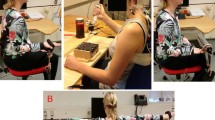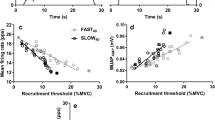Abstract
Activity of single motor units in relation to surface electromyography (EMG) was studied in 11 subjects in attention-demanding work tasks with minimal requirement of movement. In 53 verified firing periods, single motor units fired continuously from 30 s to 10 min (duration of the experiment work task) with a stable median firing rate in the range of 8–13 Hz. When the integrated surface EMG were stable, the motor units identified as a rule were continuously active with only small modulations of firing rate corresponding to low-amplitude fluctuations in surface EMG. Marked changes in the surface EMG, either sudden or gradual, were caused by recruitment or derecruitment of motor units, and not by modulations of the motor unit firing rate. Motor unit firing periods (duration 10 s-35 s) in low-level voluntary contractions (approximately 1%–5% EMGmax) performed by the same subjects showed median firing rates (7–12 Hz) similar to the observations in attention-related activation.
Similar content being viewed by others
References
Bengtsson A, Henriksson KG (1989) The muscle in fibromyalgia. A review of Swedish studies. J Rheumatol 16 [Suppl 19]: 144–149
Eken T, Kiehn O (1989) Bistable firing properties of soleus motor units in unrestrained rats. Acta Physiol Scand 136:383–394
Goldstein IB (1972) Electromyography. A measure of skeletal muscle response. In: Greenfield NS, Sternback RA (eds) Handbook of psychophysiology. Holt, Rinehart and Winston, New York, pp 329–365
Henneman E, Somjen G, Carpenter DO (1965) Functional significance of cell size in spinal motoneurones. J Neurophysiol 28:560–580
Hennig R, Lomo T (1985) Firing patterns of motor units in normal rats. Nature 314:164–166
Holstege G (1991) Descending motor pathways and the spinal motor system: limbic and non-limbic components. In: Holstege G (ed) Progress in brain research. Elsevier, Amsterdam, pp 307–421
Jensen C, Nilsen K, Hansen K, Westgaard RH (1993) Trapezius muscle load as a risk indicator for occupational shoulder-neck complaints. Int Arch Occup Environ Health 64:415–423
Jørgensen K (1970) Back muscle strength and body weight as limiting factors for work in the standing slightly-stooped position. Scand J Rehabil Med 2:149–153
Kernell D, Monster AW (1982) Motoneurone properties and motor fatigue. An intracellular study of gastrocnemius motoneurones of the cat. Exp Brain Res 46:197–204
Kiehn O (1991) Plateau potentials and active integration in the ‘final common pathway’ for motor behaviour. Trends Neurosci 14:68–73
Larsson B, Libelius R, Ohlsson K (1992) Trapezius muscle changes unrelated to static work load. Chemical and morphological controlled studies of 22 women with and without neck pain. Acta Orthop Scand 63:203–206
Larsson S-E, Bengtsson A, Bodegàrd L, Henriksson KG, Larsson J (1988) Muscle changes in work-related chronic myalgia. Acta Orthop Scand 59:552–556
Lindman R (1992) Chronic trapezius myalgia — a morphological study (Thesis). Arbete och Hälsa 34:1–48
Lindman R, Hagberg M, Ängqvist K-A, Söderlund K, Hultman E, Thornell L-E (1991) Changes in muscle morphology in chronic trapezius myalgia. Scand J Work Environ Health 17:347–355
Malmo RB (1965) Physiological gradients and behaivour. fPsychol Bull 64:225–234
Svebak S (1988) Psychogenic muscle tension. In: Apter MJ, Kerr JH, Cowles MP (eds) Advances in psychology: progress in reversal theory. Elsevier Science, Amsterdam, pp 143–162
van Boxtel A, Jessurun M (1993) Amplitude and bilateral coherency of facial and jaw-elevator EMG activity as an index of effort during a serial reaction task. Psychophysiology 30:589–604
Veiersted KB, Westgaard RH, Andersen P (1993) Electromyograpic evaluation of muscular work pattern as a predictor of trapezius myalgia. Scand J Work Environ Health 19:284–290
Wærsted M, Bjørklund RA, Westgaard RH (1991) Shoulder muscle tension induced by two VDU-based tasks of different complexity. Ergonomics 34:137–150
Wærsted M, Bjørklund RA, Westgaard RH (1994) The effect of motivation on shoulder muscle tension in attention-demanding tasks. Ergonomics 37:363–376
Westgaard RH (1988) Measurement and evaluataion of postural load in occupational work situations. Eur J Appl Physiol 57:291–304
Westgaard RH, Bjørklund R (1987) Generation of muscle tension additional to postural muscle load. Ergonomics 30:911–923
Yemm R (1968) Irrelevant muscle activity. Dent Practit Dent Res 19:51–54
Author information
Authors and Affiliations
Rights and permissions
About this article
Cite this article
Wærsted, M., Eken, T. & Westgaard, R.H. Activity of single motor units in attention-demanding tasks: firing pattern in the human trapezius muscle. Europ. J. Appl. Physiol. 72, 323–329 (1996). https://doi.org/10.1007/BF00599692
Accepted:
Issue Date:
DOI: https://doi.org/10.1007/BF00599692




